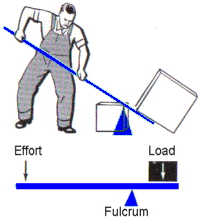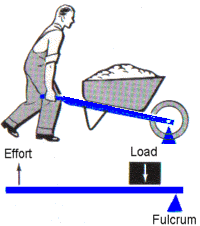 SKC Films Library SKC Films Library |
||||||||
| SKC Films Library >> Technology >> Mechanical Engineering >> Machines In General | ||||||||
| Lever the most basic of all machines A lever consists of a rod or plank that is free at both ends, and some steady object on which the plank can rest. The braced, or fixed, part is called the fulcrum. The distance from the load to the fulcrum is the load arm. The distance between the fulcrum and the lifting force is the effort arm. In its simplest form, the crowbar, the lever is a device that magnifies the effect of a small effort to move a large weight. But inverting the effort and the fulcrum changes the relationship; gripping a fishing pole and flipping a trout out of the water requires much more effort than the fish weighs, but the extra effort buys the longer distance the fish travels. How and Why a Lever Works Levers work according to a simple formula known as the Law of Equilibrium. This law is illustrated by the diagram below: the effort multiplied by its distance from the fulcrum (effort arm) equals the weight multiplied by its distance from the fulcrum (load arm). Thus, two pounds of effort exerted at a distance of four feet from the fulcrum will raise eight pounds located one foot from the fulcrum.
Classes of Levers
PRINT SOURCES |
||||||||
| SKC Films Library >> Technology >> Mechanical Engineering
>> Machines
In General This page was last updated on May 19, 2017. |


